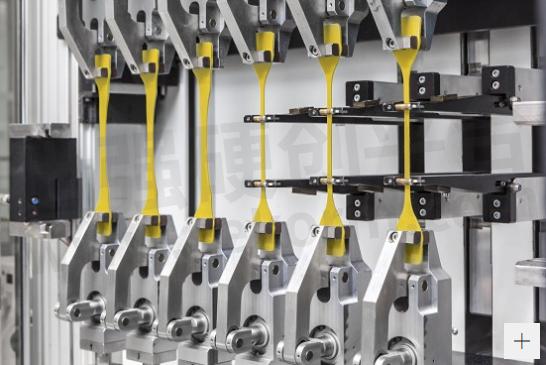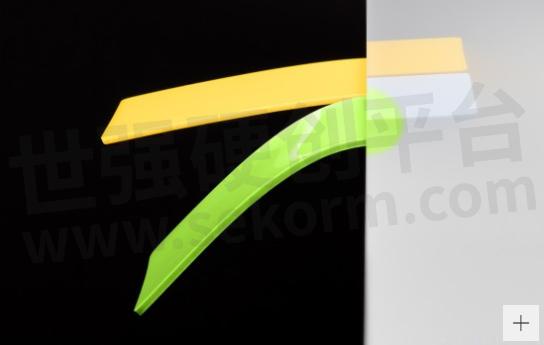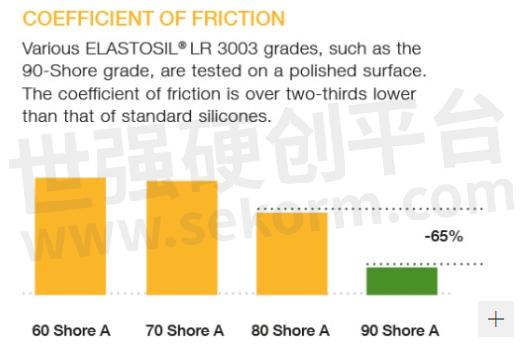WACKER Launches The Liquid Silicone Rubbers ELASTOSIL® LR 3003/90 With a Hardness of 90, Measured in Shore A

A Hard Character
The hardness and rigidity of thermoplastics and thermosets has so far been unrivaled by cured liquid silicone rubber products. Now, with ELASTOSIL® LR 3003/90, WACKER is launching a new grade. With a hardness of 90, measured in Shore A, it enables dimensionally stable silicone parts to be produced cost-effectively in an injection-molding process.
Liquid silicone rubbers can be processed in a fully automated injection-molding step, thereby enabling silicone articles to be industrially produced in a cost-effective manner. Processors achieve short cycle times during production, ideally with no need for secondary finishing – even for the smallest, high-precision and geometrically challenging finished products. The processing method can be highly automated and requires minimum personnel.
However, the cured rubber products of typical liquid silicone rubbers have one drawback when it comes to specific applications for which dimensional stability is important. “Even the hardest commercially available liquid silicone rubbers have not yet come anywhere near the rigidity of thermoplastics or thermosets,” explains Dr. Thomas Frese, who is responsible for the liquid silicone rubber product line at WACKER’s Technical Marketing department. The hardness values of cured liquid silicone rubbers are typically in the Shore A range.
WACKER has now expanded its acclaimed ELASTOSIL LR 3003 liquid silicone rubber product range to include a grade whose cured rubber products have exceptional dimensional stability and a hardness that can be measured in the Shore D range. In terms of its properties, the grade is close to the transition zone between an elastomer and a thermoplastic. “Parts produced from this liquid silicone reach a dimensional stability that would previously have been inconceivable for liquid silicone elastomers,” explains Dr. Wolfgang Schattenmann, head of the Rubber Solutions business team at WACKER SILICONES. Like all liquid silicone rubbers, the new grade is also cured via a platinum-catalyzed addition reaction, whereby the silicone polymers react with the crosslinker to form a three-dimensional network. The closer meshed the network and the more reinforcing filler the rubber contains, the harder and more rigid the resulting elastomer is after curing.

Tensile test with ELASTOSIL® LR 3003 products: following curing, ELASTOSIL® LR 3003/90 possesses extremely high rigidity, which can be derived from the slope of the stress-strain curve (see graph below).
A Skillful Combination
Both factors – the generation of a close-meshed network and the high filler content – may, however, create disadvantages during processing: firstly, the high filler content could increase the viscosity of the rubber so much that it would be virtually impossible to process by injection molding. Secondly, when establishing a high crosslink density, curing generally takes longer than for loosely crosslinking rubbers, which means longer cycle times during injection molding. There is a risk of processing via injection molding becoming uneconomical. “By skillfully selecting and combining silicone polymers and fillers, our chemists have found a way of avoiding these drawbacks when developing ELASTOSIL LR 3003/90,” stresses Schattenmann. ®
Testing the new cured-rubber grade focused on both its processing and its mechanical properties: at rest, ELASTOSIL LR 3003/90 is a paste at room temperature and displays shear-thinning behavior, becoming increasingly low viscosity with increasing shear. Even at a shear rate of a reciprocal second, the viscosity drops to approx. 800,000 millipascal seconds. Consequently, the new grade is readily fed into the injection unit using commercially available mixing and dosing equipment. The material cures rapidly, just as silicone processors are used to with the other grades in the ELASTOSIL LR 3003 product range. “The material can be easily injection molded and enables us to economically produce molded parts on a large scale.” explains Frese, who developed the new grade and is head of a WACKER applications laboratory in Burghausen.

As Hard as a Rubber Mallet
Lab staff determined the hardness of the cured rubber using both Shore A and Shore D test equipment: it is 90 Shore A or 33 Shore D – which is roughly equivalent to the hardness of a rubber mallet or a shoe heel. In comparison: gummy bears have a hardness of 10 Shore A and erasers about 30 Shore A, while the hardness of a car tire tread surface is generally between 55 and 70 Shore A.
“The unusual hardness for a liquid silicone rubber is not the only special feature of the new material,” emphasizes Frese. “Even if you manually bend a sheet made from ELASTOSIL® LR 3003/90, you notice the high rigidity of the cured material.” The cured rubber offers substantial resistance to deformation. This means that a single-sided fixed-edge panel does not sag under its own dead weight. If the deforming force is removed, the panel quickly returns to its original shape – rubber specialists often describe this property (spontaneous elasticity with highly dynamic elastic recovery) in elastomers as snap. Despite its hardness and impressive dimensional stability, the cured rubber displays remarkable elasticity and therefore also good sealing properties.
WACKER lab staff obtain more detailed information on rigidity and elasticity by using a tensile tester on the material and taking the results to produce a stress-strain curve. Stretching a test specimen from the new material by 20%, for example, requires substantially more force than for the other grades in the ELASTOSIL® LR 3003 product range.
A stress-strain diagram illustrates this difference. For the new grade, the curve increases very steeply at low deflection and is virtually linear across a large range. “The curves of the other grades are significantly flatter,” Frese reports. “Even the difference between the 80 Shore grade and the new 90 Shore grade is immense.” The steep increase in the stress-strain curve shows that the cured rubber of ELASTOSIL® LR 3003/90 has an exceptionally high modulus and so behaves like a hard spring. ®

Stress-strain diagram with curves of various grades from the ELASTOSIL® LR 3003 range including the 90-Shore grade (red). This grade undergoes hardly any strain under stress.
Highly Smooth SurfacesSilicone Elastomers
Silicone elastomers are rubber-elastic solids based on polyorganosiloxanes. They are obtained from silicone rubber in a process known as curing (vulcanizing). Here, the polymer chains of the organosilicon macromolecules form a three-dimensional network. Silicone elastomers are characterized by a property profile that makes them indispensable in many industrial applications: extraordinary heat resistance, low-temperature flexibility, chemical inertness and biocompatibility. Silicone elastomers possess a highly hydrophobic (i.e. water-repellent) surface, are selectively permeable to gases, and are very good electrical insulators. A typical characteristic is their high resistance to a large number of physical and chemical influences, which is why, unlike organic rubber compounds, they do not age. Consequently, their chemical, physical and technical properties remain virtually constant between around -50 and +200℃ – even at significantly higher temperatures using heat stabilizers; they also withstand long-lasting mechanical and electrical stress and continued exposure to oxygen, ozone and UV radiation.
ELASTOSIL® LR 3003/90 offers yet another special feature: its cured rubber is characterized by a relatively smooth surface. Generally, silicone elastomers have a rather dull surface with non-slip properties that increase with decreasing hardness. Its comparatively low surface friction makes ELASTOSIL® LR 3003/90 attractive for applications in which the silicone component moves against another component – for instance in mechanical seals or piston movements.
In its hardness and rigidity, the new material comes close to thermosets and thermoplastics, yet features a property profile that is typical of silicone and can be processed cost efficiently. „ELASTOSIL LR 3003/90 is therefore the material of choice if hard and dimensionally stable silicone parts need to be produced in large quantities,” explains Schattenmann, adding that the focus did not necessarily have to be on the silicone properties per se. The main reason for using the new silicone could also be the high productivity and extremely low defect rate that can be achieved with injection molding. For this reason, he explained, ELASTOSIL LR 3003/90 could present a beneficial alternative to thermosets or thermoplastics.
What’s more, ELASTOSIL LR 3003/90 provides a liquid silicone rubber whose cured product is extremely well suited to being a hard bonding partner in two-component molded parts. Such hard/soft combinations, i.e. plastic molded parts made of a hard and a softer material, are used in virtually all industrial sectors. Their applications include electric toothbrushes, handles for power tools, bottle tops, diving masks, weatherpacks in electrical systems and much more. The softer material is frequently used to bypass tolerances between different components. It also assumes sealing tasks, or is used because of its more pleasant feel. The automotive industry in particular uses components that have rigid and elastic elements for ventilator louver seals, gear lever guides, door lock modules, door sill cover strips or windshield cowls.
Provided the machinery and molds are suitable, combining the hard silicone grade with a softer liquid silicone rubber enables injection-molded hard/soft combinations exclusively made from silicone to be cost-effectively produced on a large scale. For instance, a soft silicone sealing lip can be sprayed on a rigid silicone substrate made of ELASTOSIL® LR 3003/90.

The surface friction of a silicone test plate is being tested here.
Previously, thermoplastic hard components have been frequently combined with soft silicone elastomers. Using the new liquid silicone rubber instead of a thermoplastic as the hard component offers advantages in terms of process reliability and productivity – the processor no longer needs to consider the substantial differences in the processing conditions such as those between thermoplastics and silicone rubbers. “ELASTOSIL® LR 3003/90 therefore opens up applications that were not previously possible with a liquid silicone rubber,” states Schattenmann.
The direct comparison of the coefficient of friction exhibited by ELASTOSIL® LR 3003 products of various hardnesses illustrates the extremely low coefficient of friction of ELASTOSIL® LR 3003/90.

- +1 Like
- Add to Favorites
Recommend
- WACKER ELASTOSIL® LR Liquid Silicone Rubber Featured with An Improved Fire Protection,Which Means Increasing Safety
- WACKER Has Produced A Liquid Silicone Rubber (LSR) ELASTOSIL® LR Series for 2K Injection Molding
- LEAP Technology Has Developed A Kind of Sensor – Based on WACKER ELASTOSIL® Silicone Films
- WACKER Presents Highly Adhesive Silicone Gel for Fixing Electronic Components at COMPAMED 2023
- WACKER Presents Silicone-Based Solutions for Electromobility and Medical Applications
- WACKER Presents Silicone Materials for Enhancing the Safety of Lithium-Ion Batteries
- WACKER Engineering Silicones Tech Center in Burghausen
- WACKER Presents Silicone Resins SILRES® H60 A/B and SILRES® H62 C for the Impregnation of Electric Motors
This document is provided by Sekorm Platform for VIP exclusive service. The copyright is owned by Sekorm. Without authorization, any medias, websites or individual are not allowed to reprint. When authorizing the reprint, the link of www.sekorm.com must be indicated.





























































































































































































































































































































































































































































































































































































































































































































































































































































































